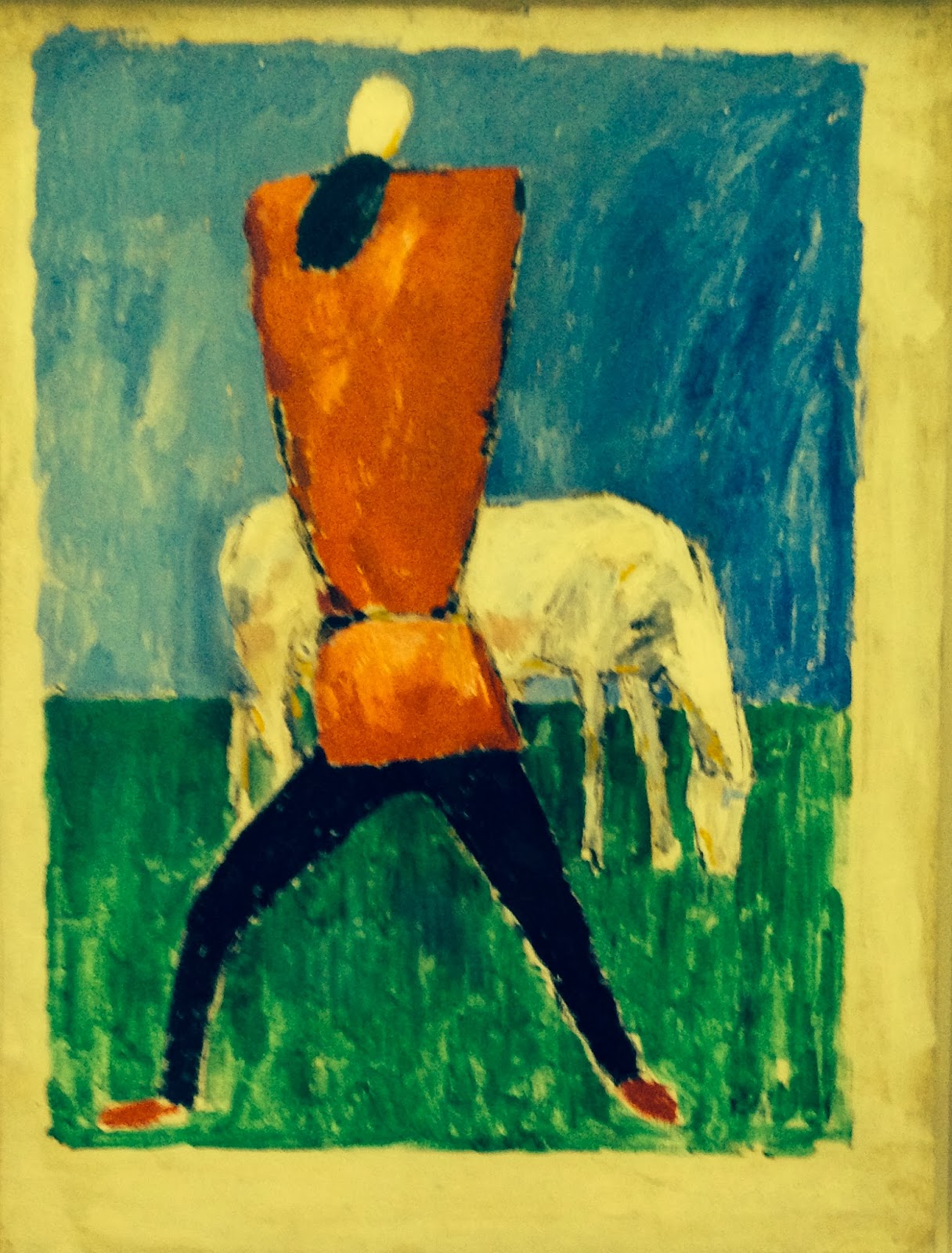CHANGING MY FEELINGS
 |
| The last version of the Black Square - 1932 |
It’s not often that I turn my back on a painting but this one made me fume. Since I have read a lot about this period in Malevich’s life. The Black Square was painted four times at different periods and in different sizes. Supposedly it is his most famous and emblematic work. I am not going to go into his reasoning as I still find it a little absurd even if considered to be the first non-objective trend in the Russian avant-garde.
We have often seen this work and others of his geometric period in exhibitions and let’s face it, they do not touch me. I really can’t relate to them. This was a period called Suprematism representing « art for art’s sake » (1919). The word came from the Latin supremus which means « the most perfect ». Aieee. However, looking at what I wanted to see in 2014, I fell on the Stedelijk Museum. An exhibition called Malevich and the Russian Avant-Garde caught my eye. I was amazed to see how much his earlier work was fascinating. I didn’t have to look at all those Supremist paintings if I went….so I decided to go.
I was very pleased to have done so. It is the largest event in many years of Kazimir Malevich’s work (1879-1935) and gives a complete picture of the artist and the Russian avant-garde. What is also fascinating is that the exhibition includes a lot of his work on paper, for him « the true home of his ideas ».
 |
| Self portrait 1910 |
 |
| On the Boulevard 1910 |
 |
| The Province 1910 |
 |
| Man with sack 1910-11 |
 |
| Windmills 1909 |
 |
| Picking of fruit 1909 |
 |
| Portrait 1910 |
 |
| Same period |
 |
| Bathers seen from behinbd 1910 |
His work evolved under the influence of the Russian folk art and modern art movements emanating from Paris. This was the period that interested me. The Neo-Primitivism and Cubo-Furturism (1911-1913.)
 |
| peasant woman with child 1911 |
 |
| The Woodcutter 1912 |
 |
| The mower 1912 |
 |
| Peasant woman with buckets 1912 |
 |
| Taking in the rye 1912 |
 |
| Study of a peasant 1911 |
 |
| Maternity 1910 |
There was a group of artists in the Cubo-Futurism and A-Logism, (an artistic style he created which was an associative collage like way of painting).His work was also very influenced by the French movement. You'll see that below. Of course there were many painters who were unknown to me (Ivan Klyun (whom I naturally did not know along with others although of course I did know Popova.)
 |
| Boris Ender - extended space 1922 |
 |
| Michail Matyushin - landscape 1920 |
 |
| Michail Matyushin space 1920 |
 |
| Michail Matyushin - painterly musical construction 1918 |
 |
| Popova - Spacial Force construction 1920 |
 |
| Popova - Painterly architectonics 1918 |
I am now going to skip his suprematism, shapes and monochrome and geometric designs. I can’t cope with them. You can judge for yourself. They are static in my eyes and don’t have the movement and energy I look for in abstract painting.
 |
| Ivan Puni 1915 |
 |
| Malevich |
 | ||
| Malevich |
 |
| Malevich |
 |
| The famous Black square and others |
 |
| The Black Square again and gallery for Suprematism |
Then we come to his last years. In 1928, Stalin’s regime officially banned abstract art. Malevich was captured and spent two months in prison under pretty tough interrogation. There he began to paint figurative scenes although this return to figuration no means signaled the end of the geometric era. All the paintings I saw possessed an unmistakeable Suprematist abstraction but one which I had no difficulty in going along with.
 |
| Head of a peasant 1930 |
 |
| Man and horse 1933 |
 |
| Running man 1930 |
 |
| Woman with rake 1932 |
 |
| Girl with a comb in her hair 1932 |
 |
| Girl with red pole 1932-33 |
 |
| Considered to be the best of his "impressionist" paintings |
 |
| self portrait 1933 |
Back in Paris it took me a full day to go through the paintings and then again last night with Nicky we spent another hour together. She was enthralled and pointed out many images in the paintings that I hadn’t seen. However, it also get’s back to my idea on titles. Many of the titles didn't have anything as far as we could see with the paintings and yet before I let her look at the title, we both fantasized on what the painting was all about. Frankly our « stories » were richer than the given titles. Or we thought so anyway. However, below are his titles.
 |
| Lady at the piano 1913 |
 |
| Station without a stop 1913 oil on wood |
 |
| Toilet Casket 1913 oil on wood |
 |
| Study for Italian landscape 1914 |
 |
| Cubo-futurist composition with piano 1913-14 - OK!! |
 |
| Woman at the tram stop 1913 |
 |
| An Englishman in Moscow 1913 - OK! |
 |
| Lady at the advertising column 1914 |
The following day there would be two exhibitions to see. One at the Hermitage and another at the Historical Jewish Museum which I had never visited.



Commentaires